Category — activism
They. Them. We. Us.

My initial reaction, now quite a while ago, to the use of they and them as singular pronouns for those who identify as both she and he—or neither–was as a grammar nerd. How could one word mean two different things? How could “they” refer to both a single human and a group of humans?
This bothered me the way the whole man/mankind argument had bothered me decades before. You know, the pushback from those who insisted that Peace on Earth, Good will to Men included all people. Because, they said, we understand “man” and “mankind” to be inclusive. Because, they said, there exists in our language something called the “generic man.” And those who don’t accept this generic thing are just playing the PC card. The generic man idea was simultaneously deeply sexist and just bad (and confusing) word use. One word cannot mean two different things: an individual male human and all humans.
An aside: To test the notion that there was understanding of the generic, inclusive “man,” researchers asked elementary school girls and boys to draw pictures to illustrate a hypothetical history book with supposedly gender-inclusive chapters titled “Colonial Man” and “Democratic Man.” All of the boys and just about all of the girls drew pictures of men only.
So, I have struggled, wondering why our language has gender-neutral plural pronouns while lacking gender-neutral singular pronouns. (Happily, at least, we don’t assign gender to inanimate objects like the Romance languages: la chaise, the feminine chair; le bureau, the masculine desk.)
I know and love that language is a living thing, which means it grows and changes. And I love that people can take control of language and use it in powerful and empowering ways. So, in every way other than grammatically, I embrace they and them as personal pronouns of choice.
Here is an alternative! Ursula LeGuinn contemplated it when she wrote The Left Hand of Darkness about a world inhabited by androgynous humans: The singular pronoun per. It stands for person. The whole person, the complete and complicated person: female, male, androgynous, non-binary, intersex, trans. Just us. The inclusive us.
How about it?
Lauren Kessler
My pronouns are per and pers
July 5, 2023 6 Comments
Searching for/ Living a life of meaning

I want to be with people who submerge
in the task, who go into the fields to harvest
and work in a row and pass the bags along..
I awoke on this chilly first day of February thinking of the Marge Piercy poem “To Be of Use” and my 36 time-out-of-time days on the Camino this past fall. I was thinking about the people I met along The Way and how they were all seekers, highly privileged seekers. I don’t mean that as an insult. It is a fact: They—and I—had the privilege of moving out of our separate worlds, our separate lives, to explore and ponder what we were doing and where we would go from here. We were in a position to choose this journey, this challenge, unlike so many whose daily life is challenge enough.
I was thinking about my fellow pilgrims, the ones I walked with for minutes or hours or days: the Israeli men fresh from their military service, the Korean girls with their TikTok accounts, the burned-out political fundraiser from Massachusetts, the nurse from Colorado, the new widow from the Netherlands, the tough/tender bear of a man from Sweden, the Irish guy with his bunions, the beautiful young French woman with the sad eyes. They were walking to take a deep dive into who they were. They were walking to understand their lives, to make a change, to find meaning.
And then, because today is my regular shift at Food for Lane County’s Dining Room, where I help to serve hearty sit-down meals to those in need, I was thinking about my fellow volunteers: the nurse, the former middle school teacher, the retired magazine editor, the community college guidance counselor, the store owner, the yoga instructor. They are not out walking the Camino searching for connection and meaning. They have found it. At the Dining Room, helping to nourish and support the community they love, they are living a life (or at least a few hours) of purpose and meaning.
I admire the spirit and heart of those I met along the Camino who search for meaning. But I celebrate and deeply respect those who have found it, who submerge/in the task, who go into the fields to harvest/and work in a row and pass the bags along.
February 1, 2023 4 Comments
Numbing numbers/ Action items
Not only does the U.S. have the highest incarceration rate in the world; every single U.S. state incarcerates more people per capita than virtually any independent democracy on earth.
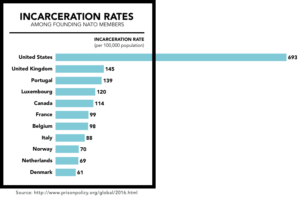
One in 7 people in US prisons (203,865) is serving a life sentence. This is more than the entire incarcerated population in 1970.
In California, it costs $106,131 a year to incarcerate an inmate.
New York City spends $556,539 to incarcerate one person for a full year, or $1,525 per day.
K-12 schools spend an average of $13,185 per pupil annually.
It costs the taxpayers of Texas $2.3 million to execute one person.
There are currently 199 people on Death Row in Texas. There are 2,436 people on Death Row in the US.
These are numbing numbers. They can also be action items.
Here is a list of prison reform organizations you can read about, support, and join.
August 31, 2022 2 Comments
Costly, ineffective, unfair

“The current system of mass incarceration is costly, ineffective, unfair, racially discriminatory, socially destructive and legally infirm.” That is Robert N. Weiner talking, a Washington, D.C. lawyer and legal strategist, as he introduces the American Bar Association’s 10 Principles on Reducing Mass Incarceration. He is stating facts not opinions..
Costly? Total U.S. government expenses on public prisons and jails: $80.7 billion. On private prisons and jails: $3.9 billion
Ineffective? The U.S. Department of Justice itself states: “sending an individual convicted of a crime to prison isn’t a very effective way to deter crime.”
Unfair and discriminatory? Black Americans are incarcerated in state prisons across the country at nearly five times the rate of whites, and Latinx people are 1.3 times as likely to be incarcerated than non-Latinx whites.
Socially destructive? As researcher and sociologist Bruce Western writes: “America’s prisons and jails have produced a … group of social outcasts who are joined by the shared experience of incarceration, crime, poverty, racial minority, and low education. As an outcast group, the men and women in our penal institutions have little access to the social mobility available to the mainstream. Social and economic disadvantage, crystallizing in penal confinement, is sustained over the life course and transmitted from one generation to the next. This is a profound institutionalized inequality that has renewed race and class disadvantage.”
Legally infirm? Mr. Weiner is one of the premier legal minds in the country. He ought to know.
At the American Bar Association’s annual meeting in Chicago earlier this month, the House of Delegates passed a resolution to adopt these 10 Principles. These are not radical ideas. They are thoughtfully considered, sensible, humane—and evidence-based. Prison reformers and social justice warriors have been highlighted all these and more for decades. It is notable that the mighty and powerful ABA is now taking this stand.
Limit the use of pretrial detention.
Increase the use of diversion programs and other alternatives to prosecution and incarceration.
Abolish mandatory minimum sentences.
Expand the use of probation, community release and other alternatives to incarceration, and create the fewest restrictions possible while promoting rehabilitation and protecting public safety.
End incarceration for the failure to pay fines or fees without first holding an ability-to-pay hearing and finding that a failure to pay was willful.
Adopt “second look” policies that require regular review and, if appropriate, reduction of lengthy sentences.
Broaden opportunities for incarcerated individuals to reduce their sentences for positive behavior or completing educational, training or rehabilitative programs.
Increase opportunities for incarcerated individuals to obtain compassionate release.
Evaluate the effectiveness of prosecutors based on their impact on public safety and not their number of convictions.
Evaluate the effectiveness of probation and parole officers based on their success in helping probationers and parolees and not their revocation rates.
August 17, 2022 No Comments
Thinking the (previously) unthinkable

I rejoice in the power of (some) corporations.
I vigorously support the doctrine of states’ rights.
I believe the South was right: If your values and beliefs, if your everyday and embedded culture, if your very way of life is at odds with the country to which you have previously pledged your allegiance, secede.
My younger self—and by “younger” I mean pre-2016—never could have imagined my 2022 self writing these words. Thinking these thoughts. Embracing these ideas.
Yet it is corporations–and not our elected officials, not our public servants–that are leading the resistance against the assault of women’s reproductive freedom. In this land where I used to despair that “money talks,” I salute and celebrate (and will do my business with) the big corporations that have publicly announced their opposition to the overturn of Roe by putting their money where their big corporate mouths are.
These companies are funding abortions and associated travel for their employees: Starbucks, Tesla, Yelp, Airbnb, Microsoft, Netflix, Patagonia, DoorDash, JPMorgan Chase, Levi Strauss, PayPal, Amazon, Reddit, Walt Disney Company, Meta, Dick’s Sporting Goods, Condé Nast, Johnson & Johnson, Warner Bros, Bank of America, Intuit, Zillow, Lyft, Uber, Adobe, Vox, H&M, Accenture, Expedia, URBN, Estée Lauder Companies, Chobani, Yahoo, The Body Shop, Discord, Rivian, Bumble, Bloomberg L.P., Ralph Lauren, Sephora, Neiman Marcus Group, Vanguard, Match Group.
And I am now in favor of that line of thinking that the federal government’s power ought to be limited to minting money and waging war (and really, forget the war thing) and all other powers reside with the individual states.
Especially if your state is Oregon. And your state passes legislation enshrining women’s reproductive freedom. And your state enacts an aggressive climate protection program with a plan to cut greenhouse gas emission by 90 percent. And your state creates and funds a plan that provides free (or very low cost) health coverage for tens of thousands of working families, pregnant women and seniors. And you know what: We don’t have to pump our own gas.
And about secession: Yes. I cannot pledge allegiance to this country we have become.
I am a citizen of Cascadia.
I am a citizen of Ecotopia.
July 6, 2022 1 Comment
Money Talks
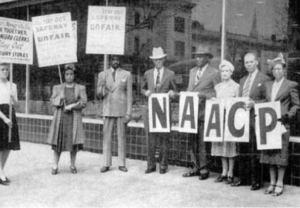
(Boycott against Safeway until they employed African Americans in 1941)
When logic and reason get you nowhere, when compassion and empathy and understanding are absent, when integrity and principles and ethics are discarded, there is always, here in the U.S. of A. the Great God Money.
Money Talks.
As we move forward, as we transform our shock, fury and pain into action, as we consider what we can do to (once again) fight for the right to control our own bodies, let’s consider the boycott. Boycotts work.
(Brief historical sidebar)
In the 1920s, the auto tycoon Henry Ford ran a weekly newspaper, the Dearborn Independent, which regularly published anti-Semitic articles. In response, the Anti-Defamation League helped to organize a boycott of his cars. After a dramatic hit on sales revenue (and after Fox Film Corporation threatened to show footage of wrecked Ford vehicles before showing films in its cinemas across the country), Ford apologized and shut down the newspaper in 1927.
In July 2018, Ivanka Trump closed her fashion brand after boycotts from consumers following her father Donald Trump’s election in November 2016. The Wall Street Journal reported sales of her brand at Amazon, Bloomingdales and Macy’s fell almost 45 percent in the year to June.
Find more inspiring examples of successful boycotts here and here.
We know which states have so-called trigger laws that immediately abolished women’s reproductive freedom after the overturn of Roe. We know which states will soon follow. We know which states already have Draconian restrictions and will likely move to abolish.
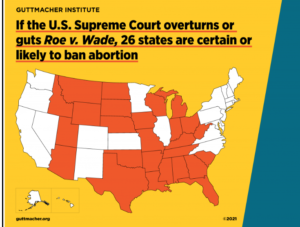
Of the many actions we can and must take, let’s let our money talk. Do not travel to these states and spend your money there. If your organization holds a conference in one of these states, refuse to go. Do not buy goods sold by companies headquartered in these states.
Conversely, a number of companies have announced their support of women’s reproductive rights by covering abortion travel expenses for those employees living in states where the safe termination of pregnancy is no longer possible. Support these companies. Money talks.
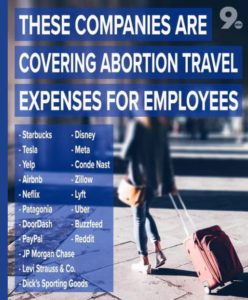
June 29, 2022 1 Comment
The Revolving Door

Get out of prison. Walk out the gate. Head over to the nearest 7-11. Rob it. Get caught. Go back inside.
Get out of prison. Walk out the gate. Go steal a car. Get caught. Go back inside
Recidivism, the rate at which former inmates run afoul of the law again, is one of the most commonly accepted measures of success (or, actually, failure) in our criminal justice system. The numbers are dismal. About three-quarters of inmates released from state prisons are rearrested within five years of their release.
But wait. Dig a little deeper—as researchers have done—and a far more nuanced picture emerges. For example: Most of the returns to prison in New York — 78 percent — were triggered not by fresh offenses but by parole violations, such as failing drug tests or skipping meetings with parole officers.
This is what the Marshall Project calls the Misleading Math of Recidivism.
When calculating recidivism rates, various states use different measures. Some states lump violating parole (technical violations like missing an appointment with a parole officer, failing to pay a restitution fine, failing to report travel), minor infractions that can trigger arrest (for example, a traffic violation, vagrancy), and committing a new crime as examples of recidivism. Other studies count only convictions for new crimes.
In other words, when we hear about the extraordinarily high rates of recidivism, we often don’t know what’s being counted. What we do know—what many people feel—is afraid. Let those bad folks out, and what do they do? They continue to be a threat to us and our communities. Keep ‘em inside. Throw away the key.
It is infinitely more helpful to think about (and question) those numbers in other ways:
What is being counted?
Why might there be so many parole violations? (Is parole overly punitive? Do parole officers have such excessive caseloads that they have no time to get to know their parolees and help them be successful? What are the most common violations and how can we restructure the demands of parole to mitigate this?)
And, most urgently and importantly, if prison is supposed to be about both punishment and rehabilitation, why is the rehabilitation component so weak (or nonexistent) that for some crimes—burglary and drug crimes top that list–there is, indeed, a revolving door.
Here’s surprising fact to chew on: The most violent prisoners are the least likely to end up back in jail.One percent of released killers ever murder a second time.
I hope you will want to read about the post-prison lives of six people—five of whom committed violent offenses and served decades inside, one with life-long addiction problems—in my new book, Free: Two Years, Six Lives, and the Long Journey Home.
None are back in prison.
June 1, 2022 7 Comments
Framing. Naming.

The postings, the “manifestos,” the random spewings that fueled the Buffalo rampage…This is hate speech: brutal, ugly and obvious. It vilifies. It targets. It ignites fear. It incites violence.
But there are more subtle ways of directing hostility and engendering fear. There is word choice, sometimes nuanced. There are what facts are included and in what order. This framing and naming can go unnoticed. But that does not mean it is without consequences.
Within about a week of each other, two substantial pieces of journalism appeared that focused on issues related to incarceration in Oregon. One was a long, meticulously documented investigation by a senior reporter for the Huffington Post. It was centered on Mark Wilson, a “jailhouse lawyer.” The other was a story in the Oregonian about an ongoing investigation into possible “financial discrepancies” in the oldest and largest prison club at Oregon State Penitentiary, the Lifers’ Unlimited Club.
In the HuffPost story, Mr. Wilson is introduced in the first paragraph as “a prominent incarcerated legal assistant with a near-perfect disciplinary record who has helped thousands of other prisoners pursue legal claims.” The work he has done is then detailed. In this story, we first discover what Mr. Wilson has made of his incarcerated life since his 1986 crime. Then, 12 paragraphs later, we learn that when “he was 18 and addicted to methamphetamine, he took part in a double homicide during a home burglary.” We know the crime. We know the context. But first we met the man.
The Oregonian story, is introduced with this headline: Prison club for Oregon’s convicted killers investigated
Many, but not all, of the members of the Lifers’ Unlimited Club are convicted killers. There are other reasons to be sentenced to life. Regardless, the article is not about the crimes any of the members committed 20, 30 or 40 years ago, it is about how the Club functions now. Who are the men in charge of the club? Did they do anything wrong managing the operation of the club? That is the question.
But when the reader is first introduced to the club treasurer, the very first thing we learn is that he was “convicted of aggravated murder in the beating death of…” Later, the editor of the club’s newsletter is introduced to us by several sentences detailing the crime he committed 34 years ago.
These crimes happened. These men are guilty. Absolutely. But how does knowing this before we know anything else about them affect our suspicions of their potential wrongdoing in club activities? Don’t we begin with bias? Conversely, how does learning about Mr. Wilson’s legal work first, rather than his crime first, affect how we view this man?
Ninety-five percent of everyone who is incarcerated in the US eventually get out. That includes most members of the Lifers’ Club. If we learn to see them only through the lens of their terrible past, if we identify them by the very worst thing they ever did, how can we not be afraid of them? How can we possibly welcome them back into our communities?
I hope you will read about the post-incarceration lives I chronicle in my new book, Free: Two Years, Six Lives and the Long Journey Home. Is it possible to reclaim your life? Is it possible to do good after causing so much harm?
May 18, 2022 2 Comments
Why did I write this book?
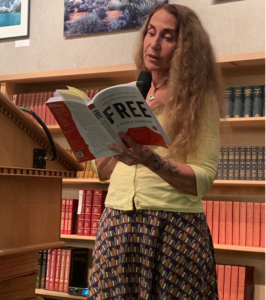
Oregon author tells the stories of 6 people coming back to society from prison
By Amy Wang | The Oregonian/OregonLive
Eugene author Lauren Kessler sums up America’s approach to incarceration this way in her new book:
“We want those who have done harm to us to suffer, to pay for what they did,” she writes. “But in making them suffer, we create the kind of human beings we do not want back in our communities.”
Q: “Free” reads like a companion book for “A Grip of Time,” your 2019 book about men serving life sentences. How did you become interested in the subject of incarceration in the first place?
A: My general interest is these hidden subcultures in our midst that are peopled by, in this case, 2.3 million people that we know very little about…
If we have an epidemic of mass incarceration, then we also have the companion crisis of re-entry: 600,000 men and women coming back to our communities. Most of whom want to remake their life; they don’t want to go back. And so I wanted to know what that journey was like.
Q: If readers take away one thing from this book, what would you hope that would be?
A: So these men and women come back to our communities. We need to give them a chance to show us that they can be good citizens and community members. There are thousands in Oregon.
Other great questions include:
Q: Aside from housing and jobs, what facets of re-entry did you focus on and why?
Q: What were your thoughts about victims and their families and how they might respond to this book?
For the rest of the interview please click here.
May 11, 2022 No Comments
Walking the talk
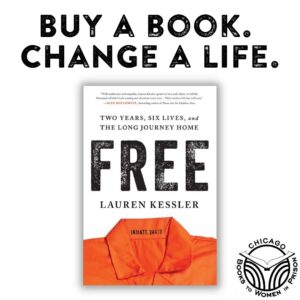
When I started going into prison to run a writers’ group for lifers, I wanted to help the men find their voices and tell their stories, and I also wanted to learn from them about the realities of incarcerated life, that hidden-from-view world inhabited by 2.3 million people in our country. As we talked about the art and craft of writing I kept suggesting books they could read that exemplified the power of nonfiction storytelling. None of those books were in the prison library.
But to be a writer one has to read good writing, yes? And to prepare for freedom one has to be able to practice (and hold dear) intellectual freedom: the opportunity to read books that open new worlds; the chance to write with clarity and passion about the world one currently inhabits.
During the three years the group met, I was able to bring in—volume by volume–quality books about writing techniques along with dozens and dozens of narrative nonfiction books culled from my own library and used bookstores. I had the extraordinary support of a prison staffer. The prison’s furniture shop created a tall wooden cabinet to house the “Writers’ Collection.” One of the men volunteered to be the lending librarian. We bragged about it shamelessly. And they read voraciously.
And now, thanks to a partnership between the publisher of my new book, FREE: Two Years, Six Lives and the Long Journey Home, and the nonprofit Chicago Books to Women in Prison, I get to be involved in helping to build prison libraries on a national scale.
For every copy of FREE sold (it doesn’t matter from what retailer) between April 1 and May 27, Sourcebooks will donate a (different) book to Chicago Books to Women in Prison to distribute free of charge to state prisons in Arizona, California, Florida, Illinois, Indiana, Kentucky, Mississippi and Ohio, as well as all federal prisons.
Their mission statement: “We are dedicated to offering the opportunity for self-empowerment, education and entertainment that reading provides.”
Because BOOKS CHANGE LIVES. (Which just happens to be the motto of my publisher.) And Sourcebooks walks the talk.
FREE is about how people reclaim and remake (and reimagine) their lives after long-term incarceration. I hope the stories I was privileged to tell give realistic hope to those who will someday be free. I hope these stories help families and friends and communities understand how freedom can be simultaneously joyful and overwhelming. I hope these stories bring into focus what it takes to help these folks be successful. What we need to do.
And now I get to hope a new hope: That with this partnership, my book, the sale of my book, will result in thousands of books donated to those behind bars. You can be part of this too.
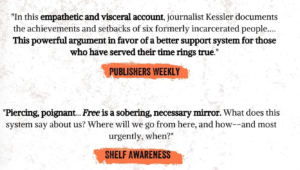
April 6, 2022 4 Comments





